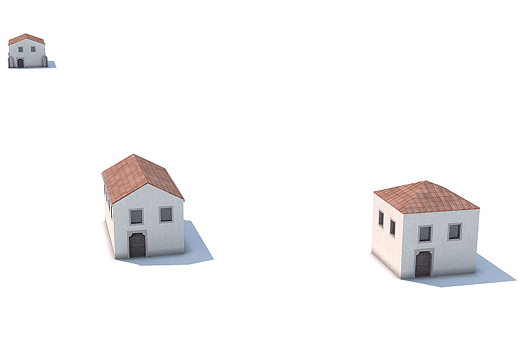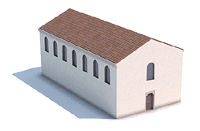- Home
- The town and the abbey
- The site from its origins
- Early history
- The basilica and structures from Late Antiquity
Hypothetical restitution of the buildings unearthed north of the basilica. © Ministère de la culture / M. Wyss, A.-B. Pimpaud, M.-O. Agnes.
Excavations carried out north of the basilica have revealed the presence of at least three stone buildings from Late Antiquity. The very fragmentary remains of these structures-which appeared at the edge of the excavated zone-mean that we cannot be certain about their appearance. All three constructions share the same orientation, and they appear to be part of the same establishment. They seem to have been of modest size. The corners of one building, which is rectangular, are reinforced by buttresses. Another, which is reconstructed here with a square floor plan, has an interior floor which is below ground level. It must have been splendidly decorated, as testified to by the fragments of painted wall plaster and stucco found in the vicinity.
Hypothetical restitution of the first church built on the tomb of Denis. © Ministère de la culture M. Wyss, A.-B. Pimpaud, M.-O. Agnes
Excavating beneath the basilica in 1958, Édouard Salin, Michel Fleury and Jules Formigé uncovered the solidly-constructed masonry of the first church. This construction was built along an axis-determined by the grave of Denis-that was noticeably different from other nearby buildings. The far eastern end had disappeared. Our reconstruction is based on the proposal by the archaeologist Sumner McKnight Crosby according to which the church ended in a straight wall whose interior face ran along the foot of the martyr's grave. The large construction, whose interior measured nine meters wide by nearly twenty meters long, had no internal division. The single nave and the choir, which had the same width, were probably covered over by a simple ceiling protected by a pitched roof.
A word about our model of how the monumental complex developed
Building a three-dimensional view of how Saint-Denis's monuments developed between Late Antiquity and the eighteenth century was a very tricky undertaking. It was based on a detailed analysis of both archaeological and architectural data, carried out over several years and in collaboration with various experts, including archaeologists, architectural historians, architects, geologists, and so on. For early periods, for which structures can only be identified by their foundations, which are often incomplete, a large part can be only hypothesis. Research is ongoing, and our goal here is not to offer a definitive scientific report, but rather to introduce the general public to the organization of this unique complex, and to help them to understand its development.


